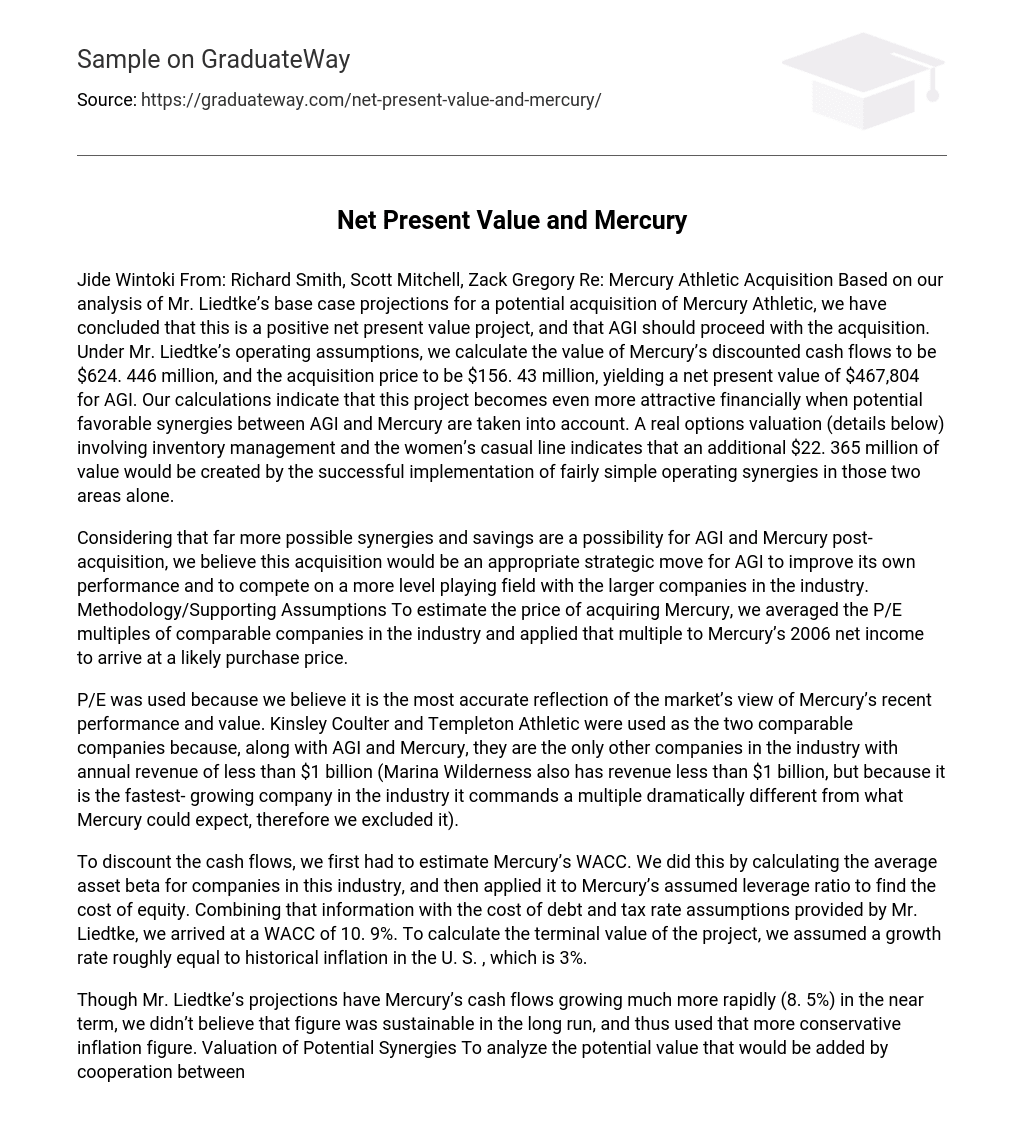Jide Wintoki From: Richard Smith, Scott Mitchell, Zack Gregory Re: Mercury Athletic Acquisition
Based on our analysis of Mr. Liedtke’s base case projections for a potential acquisition of Mercury Athletic, we have determined that it is a financially favorable project with a positive net present value. Therefore, AGI should proceed with the acquisition.
Using Mr. Liedtke’s operating assumptions, we have calculated the discounted cash flows of Mercury to be $624.446 million, and the acquisition price to be $156.43 million. This leads to a net present value of $467,804 for AGI.
We have also taken into consideration the potential synergies between AGI and Mercury, which further enhance the financial attractiveness of this project. Our calculations show that implementing relatively simple operating synergies in inventory management and the women’s casual line could create an additional $22.365 million of value through a real options valuation (details below).
In light of the potential for increased synergies and cost savings, we believe acquiring Mercury would be a strategic move for AGI. This acquisition would enhance AGI’s performance and enable it to compete more effectively with larger industry players. To determine the price of acquiring Mercury, we utilized the average P/E multiples of comparable companies in the industry and applied that multiple to Mercury’s 2006 net income. This calculation provided us with an estimated purchase price.
P/E was utilized as the most precise indicator of the market’s perception of Mercury’s recent achievement and worth. Kinsley Coulter and Templeton Athletic were employed as the two companies for comparison since, like AGI and Mercury, they are the only other enterprises in the sector generating annual revenues of less than $1 billion (Marina Wilderness also generates revenue below $1 billion; however, due to its incredibly rapid growth in the industry, it acquires a significantly distinct multiple that Mercury cannot expect, therefore it was omitted).
To estimate Mercury’s WACC, we first calculated the average asset beta for companies in this industry. We then used this information along with Mercury’s assumed leverage ratio to determine the cost of equity. By combining this with the cost of debt and tax rate assumptions provided by Mr. Liedtke, we arrived at a WACC of 10.9%. The terminal value of the project was calculated assuming a growth rate similar to historical inflation in the U.S., which is approximately 3%.
According to Mr. Liedtke, Mercury’s cash flows are projected to undergo substantial growth (8.5%) in the near future. However, we do not view this figure as sustainable over the long term. Therefore, we have chosen a more cautious inflation rate. To evaluate the potential value that collaboration between AGI and Mercury could offer, we conducted a real options valuation which specifically examined the operational synergies anticipated by Mr. Liedtke following the acquisition.
The text presents two scenarios that were analyzed: an optimistic scenario where all synergy benefits are realized and a pessimistic scenario where no synergy benefits are realized. In the optimistic scenario, it is projected that the Mercury women’s casual line will improve with 3% revenue growth and 9% EBIT. The adoption of the AGI inventory system will also reduce Mercury’s DSI to margin. The discounted present value under this scenario is $685,479 million. On the other hand, in the pessimistic scenario, the women’s casual line will continue to lose money indefinitely with no effect on EBIT from the adoption of the AGI inventory system. The discounted present value under this scenario is $608.43 million.
A sensitivity analysis of the results shows that regardless of different assumptions about Mercury’s debt level and future revenue growth, this project would still have a positive NPV for AGI. Even if Mercury’s capital structure consists of 100% or 0% debt, the NPV remains positive. Furthermore, the discounted cash flows from 2007-2011 are enough to cover the estimated purchase price, so changes in the terminal value revenue growth do not affect whether this project has a positive or negative NPV.





